Analyzing the Problems of the Articles of Confederation in US History
VerifiedAdded on 2021/10/29
|7
|2016
|39
Essay
AI Summary
This essay examines the significant problems and weaknesses inherent in the Articles of Confederation, the first constitution of the United States. It details the historical context, including the motivations behind its creation and the subsequent dissatisfaction that led to the Constitutional Convention of 1787. The essay highlights key issues such as the weak central government, which lacked the power to enforce laws or collect taxes effectively, and the undue powers granted to individual states, resulting in conflicts and economic instability. It draws upon the writings of prominent figures like James Madison, Alexander Hamilton, and Catherine Drinker Bowen to analyze the shortcomings of the Articles, particularly its failure to establish a balance between state and federal powers. The essay explores the impact of these weaknesses on trade, currency, and the overall unity of the nation, ultimately leading to the formation of the United States Constitution to address these critical deficiencies and establish a more robust and effective government. The analysis highlights the role of key individuals, debates, and compromises that shaped the transition from the Articles to the Constitution.
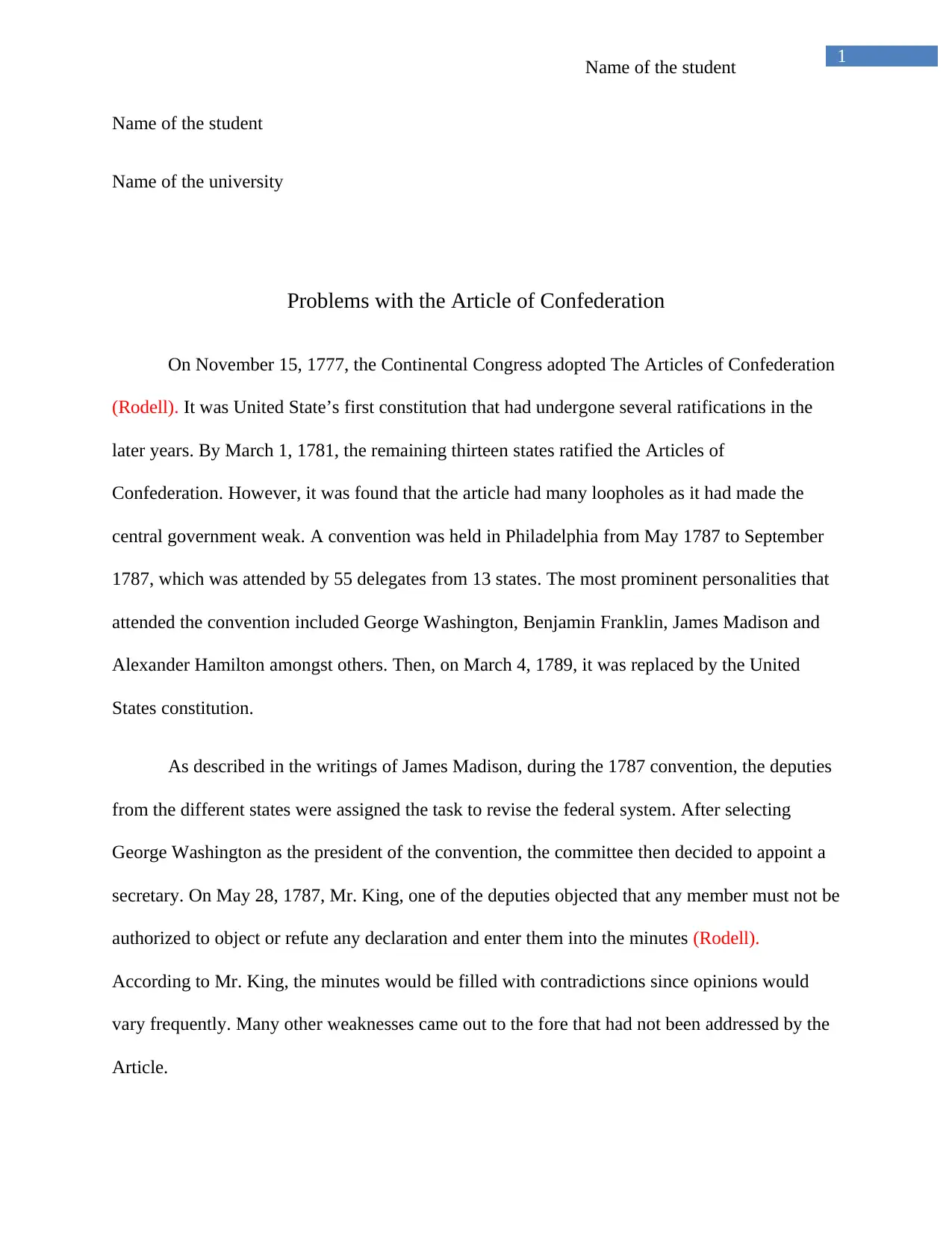
1
Name of the student
Name of the student
Name of the university
Problems with the Article of Confederation
On November 15, 1777, the Continental Congress adopted The Articles of Confederation
(Rodell). It was United State’s first constitution that had undergone several ratifications in the
later years. By March 1, 1781, the remaining thirteen states ratified the Articles of
Confederation. However, it was found that the article had many loopholes as it had made the
central government weak. A convention was held in Philadelphia from May 1787 to September
1787, which was attended by 55 delegates from 13 states. The most prominent personalities that
attended the convention included George Washington, Benjamin Franklin, James Madison and
Alexander Hamilton amongst others. Then, on March 4, 1789, it was replaced by the United
States constitution.
As described in the writings of James Madison, during the 1787 convention, the deputies
from the different states were assigned the task to revise the federal system. After selecting
George Washington as the president of the convention, the committee then decided to appoint a
secretary. On May 28, 1787, Mr. King, one of the deputies objected that any member must not be
authorized to object or refute any declaration and enter them into the minutes (Rodell).
According to Mr. King, the minutes would be filled with contradictions since opinions would
vary frequently. Many other weaknesses came out to the fore that had not been addressed by the
Article.
Name of the student
Name of the student
Name of the university
Problems with the Article of Confederation
On November 15, 1777, the Continental Congress adopted The Articles of Confederation
(Rodell). It was United State’s first constitution that had undergone several ratifications in the
later years. By March 1, 1781, the remaining thirteen states ratified the Articles of
Confederation. However, it was found that the article had many loopholes as it had made the
central government weak. A convention was held in Philadelphia from May 1787 to September
1787, which was attended by 55 delegates from 13 states. The most prominent personalities that
attended the convention included George Washington, Benjamin Franklin, James Madison and
Alexander Hamilton amongst others. Then, on March 4, 1789, it was replaced by the United
States constitution.
As described in the writings of James Madison, during the 1787 convention, the deputies
from the different states were assigned the task to revise the federal system. After selecting
George Washington as the president of the convention, the committee then decided to appoint a
secretary. On May 28, 1787, Mr. King, one of the deputies objected that any member must not be
authorized to object or refute any declaration and enter them into the minutes (Rodell).
According to Mr. King, the minutes would be filled with contradictions since opinions would
vary frequently. Many other weaknesses came out to the fore that had not been addressed by the
Article.
Paraphrase This Document
Need a fresh take? Get an instant paraphrase of this document with our AI Paraphraser
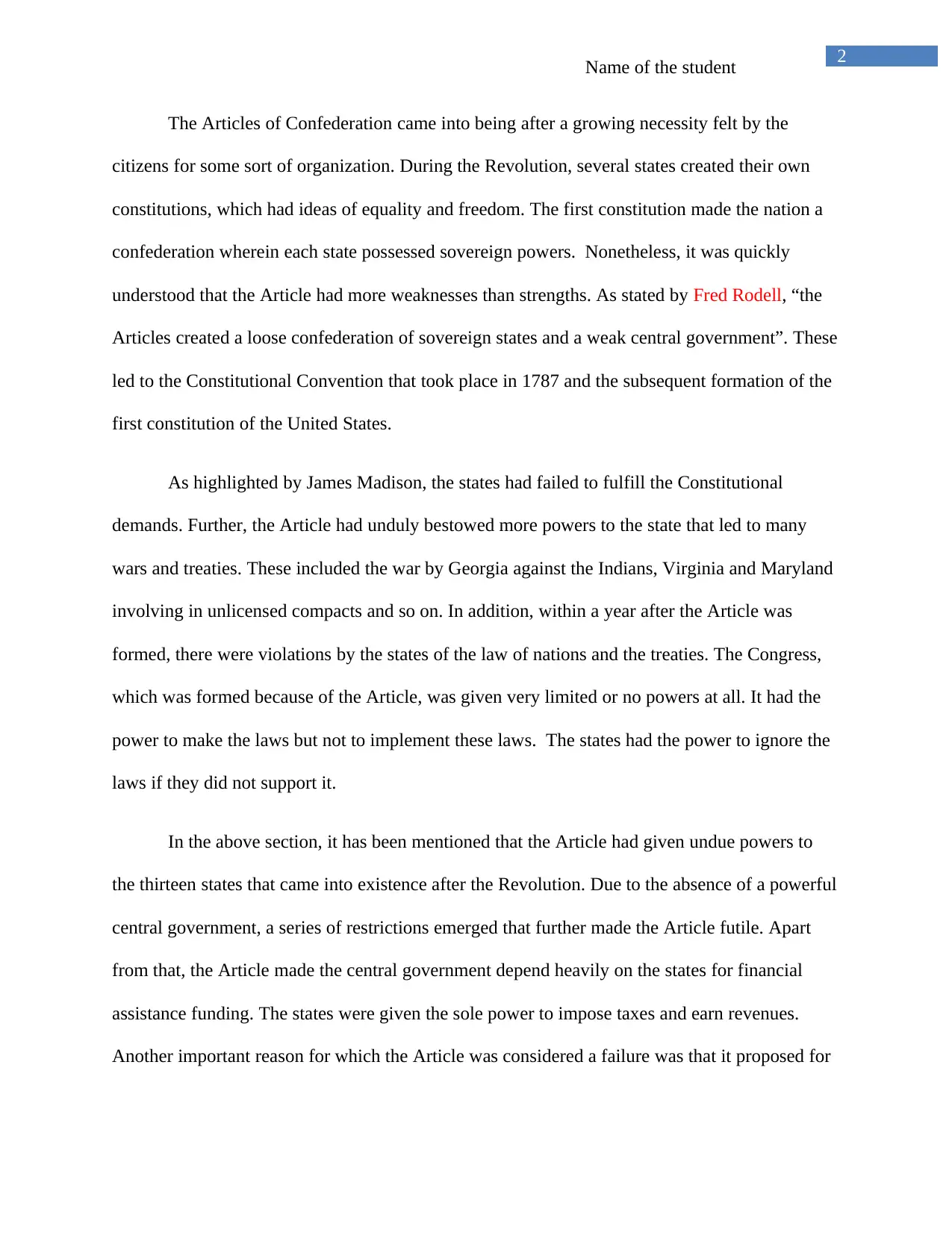
2
Name of the student
The Articles of Confederation came into being after a growing necessity felt by the
citizens for some sort of organization. During the Revolution, several states created their own
constitutions, which had ideas of equality and freedom. The first constitution made the nation a
confederation wherein each state possessed sovereign powers. Nonetheless, it was quickly
understood that the Article had more weaknesses than strengths. As stated by Fred Rodell, “the
Articles created a loose confederation of sovereign states and a weak central government”. These
led to the Constitutional Convention that took place in 1787 and the subsequent formation of the
first constitution of the United States.
As highlighted by James Madison, the states had failed to fulfill the Constitutional
demands. Further, the Article had unduly bestowed more powers to the state that led to many
wars and treaties. These included the war by Georgia against the Indians, Virginia and Maryland
involving in unlicensed compacts and so on. In addition, within a year after the Article was
formed, there were violations by the states of the law of nations and the treaties. The Congress,
which was formed because of the Article, was given very limited or no powers at all. It had the
power to make the laws but not to implement these laws. The states had the power to ignore the
laws if they did not support it.
In the above section, it has been mentioned that the Article had given undue powers to
the thirteen states that came into existence after the Revolution. Due to the absence of a powerful
central government, a series of restrictions emerged that further made the Article futile. Apart
from that, the Article made the central government depend heavily on the states for financial
assistance funding. The states were given the sole power to impose taxes and earn revenues.
Another important reason for which the Article was considered a failure was that it proposed for
Name of the student
The Articles of Confederation came into being after a growing necessity felt by the
citizens for some sort of organization. During the Revolution, several states created their own
constitutions, which had ideas of equality and freedom. The first constitution made the nation a
confederation wherein each state possessed sovereign powers. Nonetheless, it was quickly
understood that the Article had more weaknesses than strengths. As stated by Fred Rodell, “the
Articles created a loose confederation of sovereign states and a weak central government”. These
led to the Constitutional Convention that took place in 1787 and the subsequent formation of the
first constitution of the United States.
As highlighted by James Madison, the states had failed to fulfill the Constitutional
demands. Further, the Article had unduly bestowed more powers to the state that led to many
wars and treaties. These included the war by Georgia against the Indians, Virginia and Maryland
involving in unlicensed compacts and so on. In addition, within a year after the Article was
formed, there were violations by the states of the law of nations and the treaties. The Congress,
which was formed because of the Article, was given very limited or no powers at all. It had the
power to make the laws but not to implement these laws. The states had the power to ignore the
laws if they did not support it.
In the above section, it has been mentioned that the Article had given undue powers to
the thirteen states that came into existence after the Revolution. Due to the absence of a powerful
central government, a series of restrictions emerged that further made the Article futile. Apart
from that, the Article made the central government depend heavily on the states for financial
assistance funding. The states were given the sole power to impose taxes and earn revenues.
Another important reason for which the Article was considered a failure was that it proposed for
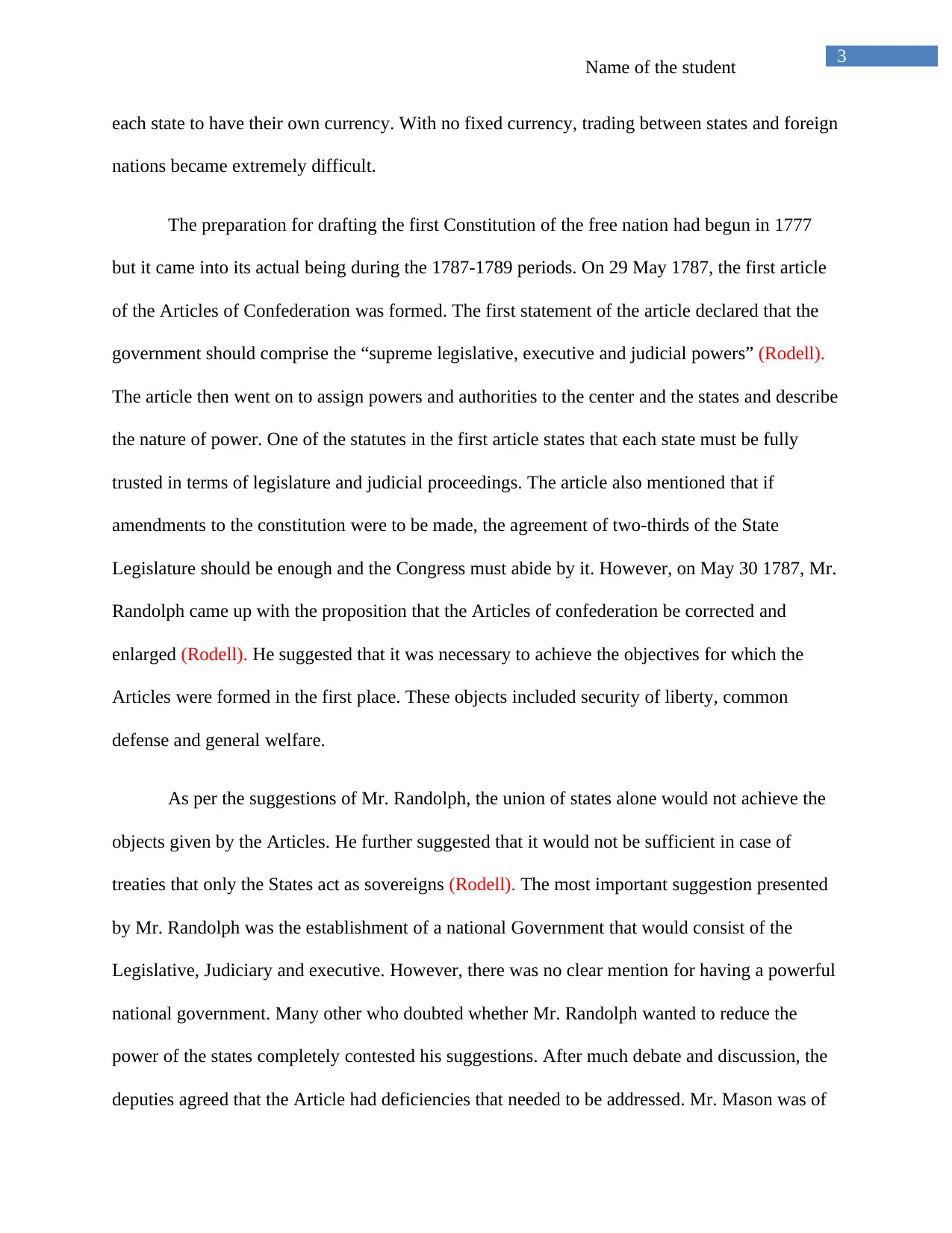
3
Name of the student
each state to have their own currency. With no fixed currency, trading between states and foreign
nations became extremely difficult.
The preparation for drafting the first Constitution of the free nation had begun in 1777
but it came into its actual being during the 1787-1789 periods. On 29 May 1787, the first article
of the Articles of Confederation was formed. The first statement of the article declared that the
government should comprise the “supreme legislative, executive and judicial powers” (Rodell).
The article then went on to assign powers and authorities to the center and the states and describe
the nature of power. One of the statutes in the first article states that each state must be fully
trusted in terms of legislature and judicial proceedings. The article also mentioned that if
amendments to the constitution were to be made, the agreement of two-thirds of the State
Legislature should be enough and the Congress must abide by it. However, on May 30 1787, Mr.
Randolph came up with the proposition that the Articles of confederation be corrected and
enlarged (Rodell). He suggested that it was necessary to achieve the objectives for which the
Articles were formed in the first place. These objects included security of liberty, common
defense and general welfare.
As per the suggestions of Mr. Randolph, the union of states alone would not achieve the
objects given by the Articles. He further suggested that it would not be sufficient in case of
treaties that only the States act as sovereigns (Rodell). The most important suggestion presented
by Mr. Randolph was the establishment of a national Government that would consist of the
Legislative, Judiciary and executive. However, there was no clear mention for having a powerful
national government. Many other who doubted whether Mr. Randolph wanted to reduce the
power of the states completely contested his suggestions. After much debate and discussion, the
deputies agreed that the Article had deficiencies that needed to be addressed. Mr. Mason was of
Name of the student
each state to have their own currency. With no fixed currency, trading between states and foreign
nations became extremely difficult.
The preparation for drafting the first Constitution of the free nation had begun in 1777
but it came into its actual being during the 1787-1789 periods. On 29 May 1787, the first article
of the Articles of Confederation was formed. The first statement of the article declared that the
government should comprise the “supreme legislative, executive and judicial powers” (Rodell).
The article then went on to assign powers and authorities to the center and the states and describe
the nature of power. One of the statutes in the first article states that each state must be fully
trusted in terms of legislature and judicial proceedings. The article also mentioned that if
amendments to the constitution were to be made, the agreement of two-thirds of the State
Legislature should be enough and the Congress must abide by it. However, on May 30 1787, Mr.
Randolph came up with the proposition that the Articles of confederation be corrected and
enlarged (Rodell). He suggested that it was necessary to achieve the objectives for which the
Articles were formed in the first place. These objects included security of liberty, common
defense and general welfare.
As per the suggestions of Mr. Randolph, the union of states alone would not achieve the
objects given by the Articles. He further suggested that it would not be sufficient in case of
treaties that only the States act as sovereigns (Rodell). The most important suggestion presented
by Mr. Randolph was the establishment of a national Government that would consist of the
Legislative, Judiciary and executive. However, there was no clear mention for having a powerful
national government. Many other who doubted whether Mr. Randolph wanted to reduce the
power of the states completely contested his suggestions. After much debate and discussion, the
deputies agreed that the Article had deficiencies that needed to be addressed. Mr. Mason was of
⊘ This is a preview!⊘
Do you want full access?
Subscribe today to unlock all pages.

Trusted by 1+ million students worldwide
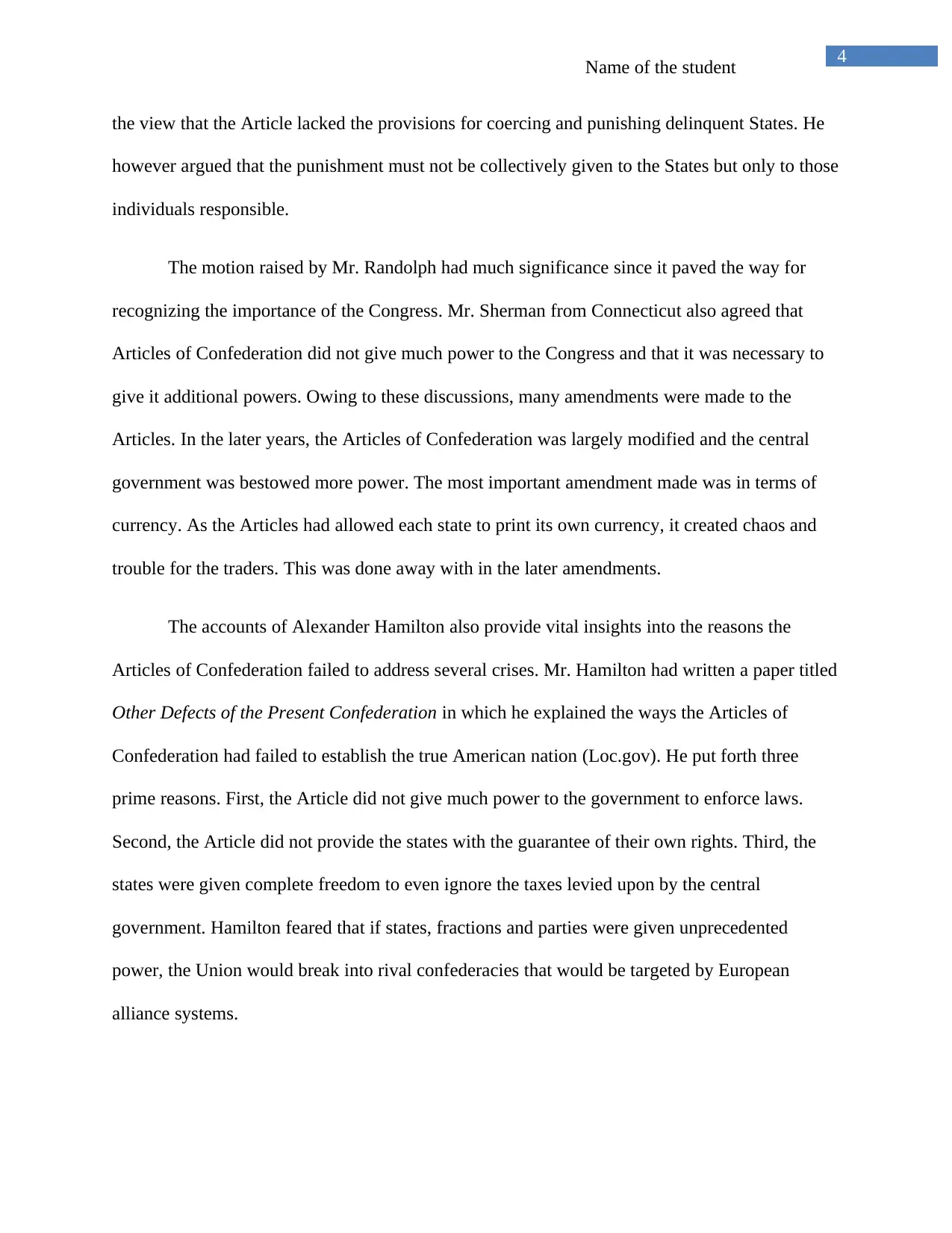
4
Name of the student
the view that the Article lacked the provisions for coercing and punishing delinquent States. He
however argued that the punishment must not be collectively given to the States but only to those
individuals responsible.
The motion raised by Mr. Randolph had much significance since it paved the way for
recognizing the importance of the Congress. Mr. Sherman from Connecticut also agreed that
Articles of Confederation did not give much power to the Congress and that it was necessary to
give it additional powers. Owing to these discussions, many amendments were made to the
Articles. In the later years, the Articles of Confederation was largely modified and the central
government was bestowed more power. The most important amendment made was in terms of
currency. As the Articles had allowed each state to print its own currency, it created chaos and
trouble for the traders. This was done away with in the later amendments.
The accounts of Alexander Hamilton also provide vital insights into the reasons the
Articles of Confederation failed to address several crises. Mr. Hamilton had written a paper titled
Other Defects of the Present Confederation in which he explained the ways the Articles of
Confederation had failed to establish the true American nation (Loc.gov). He put forth three
prime reasons. First, the Article did not give much power to the government to enforce laws.
Second, the Article did not provide the states with the guarantee of their own rights. Third, the
states were given complete freedom to even ignore the taxes levied upon by the central
government. Hamilton feared that if states, fractions and parties were given unprecedented
power, the Union would break into rival confederacies that would be targeted by European
alliance systems.
Name of the student
the view that the Article lacked the provisions for coercing and punishing delinquent States. He
however argued that the punishment must not be collectively given to the States but only to those
individuals responsible.
The motion raised by Mr. Randolph had much significance since it paved the way for
recognizing the importance of the Congress. Mr. Sherman from Connecticut also agreed that
Articles of Confederation did not give much power to the Congress and that it was necessary to
give it additional powers. Owing to these discussions, many amendments were made to the
Articles. In the later years, the Articles of Confederation was largely modified and the central
government was bestowed more power. The most important amendment made was in terms of
currency. As the Articles had allowed each state to print its own currency, it created chaos and
trouble for the traders. This was done away with in the later amendments.
The accounts of Alexander Hamilton also provide vital insights into the reasons the
Articles of Confederation failed to address several crises. Mr. Hamilton had written a paper titled
Other Defects of the Present Confederation in which he explained the ways the Articles of
Confederation had failed to establish the true American nation (Loc.gov). He put forth three
prime reasons. First, the Article did not give much power to the government to enforce laws.
Second, the Article did not provide the states with the guarantee of their own rights. Third, the
states were given complete freedom to even ignore the taxes levied upon by the central
government. Hamilton feared that if states, fractions and parties were given unprecedented
power, the Union would break into rival confederacies that would be targeted by European
alliance systems.
Paraphrase This Document
Need a fresh take? Get an instant paraphrase of this document with our AI Paraphraser
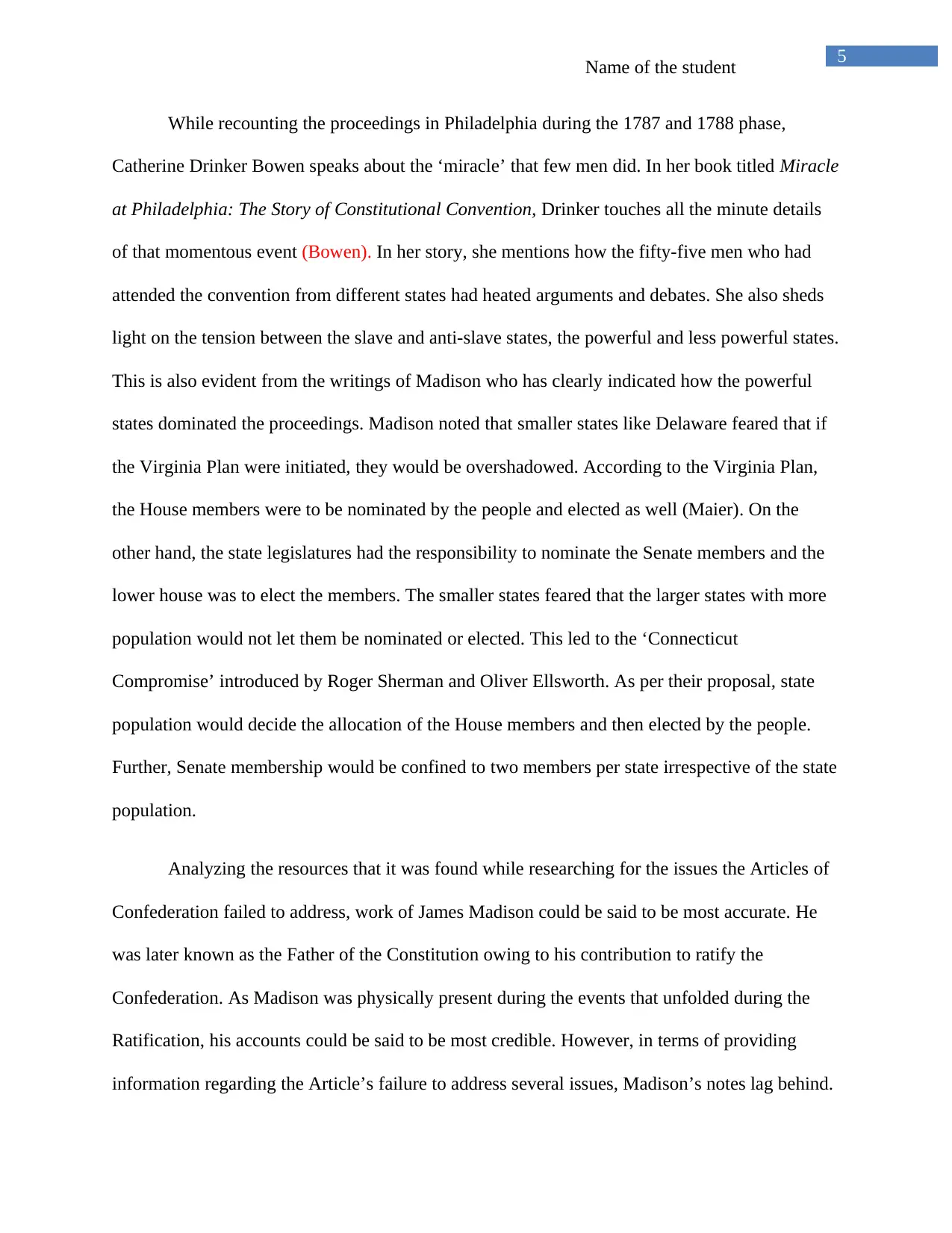
5
Name of the student
While recounting the proceedings in Philadelphia during the 1787 and 1788 phase,
Catherine Drinker Bowen speaks about the ‘miracle’ that few men did. In her book titled Miracle
at Philadelphia: The Story of Constitutional Convention, Drinker touches all the minute details
of that momentous event (Bowen). In her story, she mentions how the fifty-five men who had
attended the convention from different states had heated arguments and debates. She also sheds
light on the tension between the slave and anti-slave states, the powerful and less powerful states.
This is also evident from the writings of Madison who has clearly indicated how the powerful
states dominated the proceedings. Madison noted that smaller states like Delaware feared that if
the Virginia Plan were initiated, they would be overshadowed. According to the Virginia Plan,
the House members were to be nominated by the people and elected as well (Maier). On the
other hand, the state legislatures had the responsibility to nominate the Senate members and the
lower house was to elect the members. The smaller states feared that the larger states with more
population would not let them be nominated or elected. This led to the ‘Connecticut
Compromise’ introduced by Roger Sherman and Oliver Ellsworth. As per their proposal, state
population would decide the allocation of the House members and then elected by the people.
Further, Senate membership would be confined to two members per state irrespective of the state
population.
Analyzing the resources that it was found while researching for the issues the Articles of
Confederation failed to address, work of James Madison could be said to be most accurate. He
was later known as the Father of the Constitution owing to his contribution to ratify the
Confederation. As Madison was physically present during the events that unfolded during the
Ratification, his accounts could be said to be most credible. However, in terms of providing
information regarding the Article’s failure to address several issues, Madison’s notes lag behind.
Name of the student
While recounting the proceedings in Philadelphia during the 1787 and 1788 phase,
Catherine Drinker Bowen speaks about the ‘miracle’ that few men did. In her book titled Miracle
at Philadelphia: The Story of Constitutional Convention, Drinker touches all the minute details
of that momentous event (Bowen). In her story, she mentions how the fifty-five men who had
attended the convention from different states had heated arguments and debates. She also sheds
light on the tension between the slave and anti-slave states, the powerful and less powerful states.
This is also evident from the writings of Madison who has clearly indicated how the powerful
states dominated the proceedings. Madison noted that smaller states like Delaware feared that if
the Virginia Plan were initiated, they would be overshadowed. According to the Virginia Plan,
the House members were to be nominated by the people and elected as well (Maier). On the
other hand, the state legislatures had the responsibility to nominate the Senate members and the
lower house was to elect the members. The smaller states feared that the larger states with more
population would not let them be nominated or elected. This led to the ‘Connecticut
Compromise’ introduced by Roger Sherman and Oliver Ellsworth. As per their proposal, state
population would decide the allocation of the House members and then elected by the people.
Further, Senate membership would be confined to two members per state irrespective of the state
population.
Analyzing the resources that it was found while researching for the issues the Articles of
Confederation failed to address, work of James Madison could be said to be most accurate. He
was later known as the Father of the Constitution owing to his contribution to ratify the
Confederation. As Madison was physically present during the events that unfolded during the
Ratification, his accounts could be said to be most credible. However, in terms of providing
information regarding the Article’s failure to address several issues, Madison’s notes lag behind.
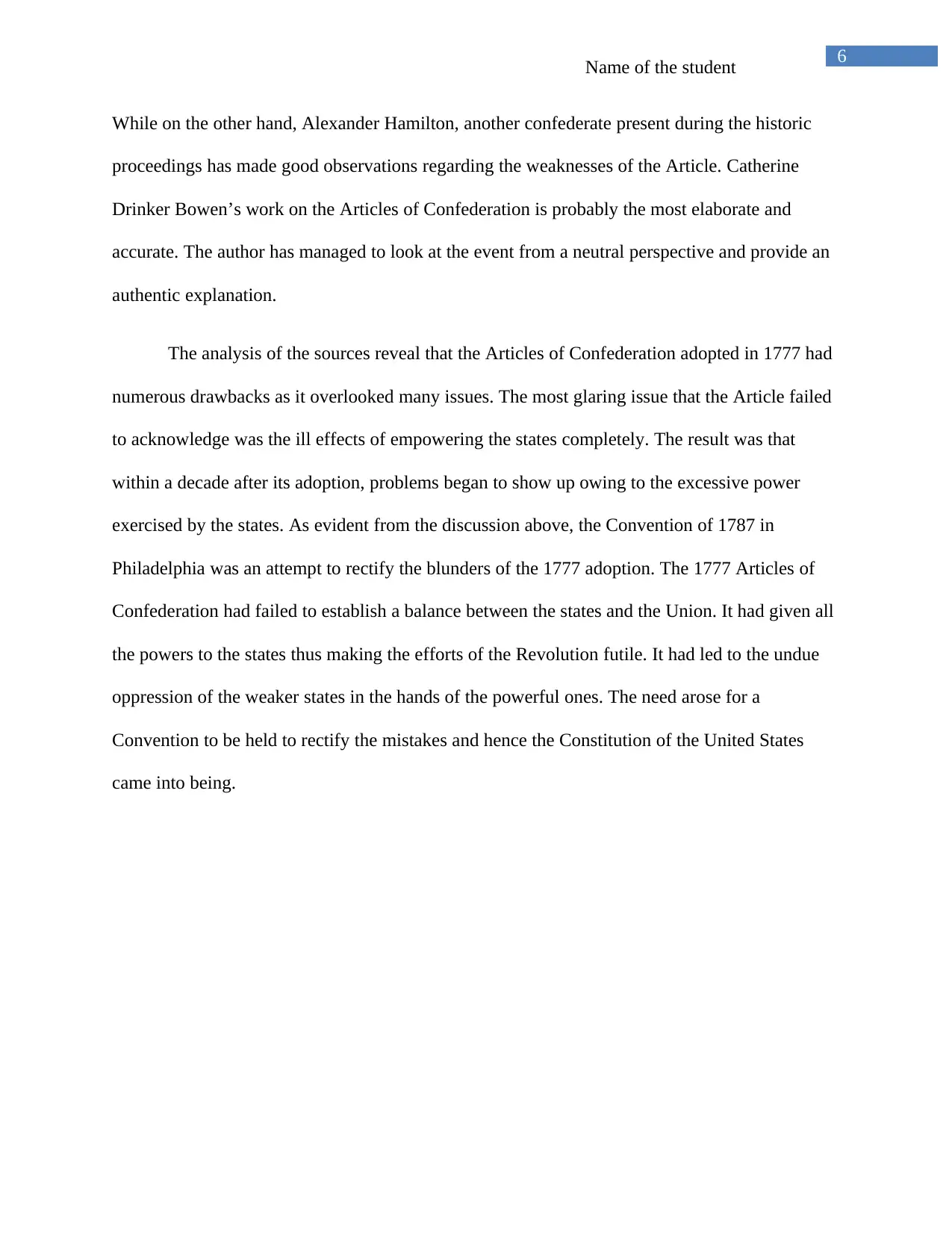
6
Name of the student
While on the other hand, Alexander Hamilton, another confederate present during the historic
proceedings has made good observations regarding the weaknesses of the Article. Catherine
Drinker Bowen’s work on the Articles of Confederation is probably the most elaborate and
accurate. The author has managed to look at the event from a neutral perspective and provide an
authentic explanation.
The analysis of the sources reveal that the Articles of Confederation adopted in 1777 had
numerous drawbacks as it overlooked many issues. The most glaring issue that the Article failed
to acknowledge was the ill effects of empowering the states completely. The result was that
within a decade after its adoption, problems began to show up owing to the excessive power
exercised by the states. As evident from the discussion above, the Convention of 1787 in
Philadelphia was an attempt to rectify the blunders of the 1777 adoption. The 1777 Articles of
Confederation had failed to establish a balance between the states and the Union. It had given all
the powers to the states thus making the efforts of the Revolution futile. It had led to the undue
oppression of the weaker states in the hands of the powerful ones. The need arose for a
Convention to be held to rectify the mistakes and hence the Constitution of the United States
came into being.
Name of the student
While on the other hand, Alexander Hamilton, another confederate present during the historic
proceedings has made good observations regarding the weaknesses of the Article. Catherine
Drinker Bowen’s work on the Articles of Confederation is probably the most elaborate and
accurate. The author has managed to look at the event from a neutral perspective and provide an
authentic explanation.
The analysis of the sources reveal that the Articles of Confederation adopted in 1777 had
numerous drawbacks as it overlooked many issues. The most glaring issue that the Article failed
to acknowledge was the ill effects of empowering the states completely. The result was that
within a decade after its adoption, problems began to show up owing to the excessive power
exercised by the states. As evident from the discussion above, the Convention of 1787 in
Philadelphia was an attempt to rectify the blunders of the 1777 adoption. The 1777 Articles of
Confederation had failed to establish a balance between the states and the Union. It had given all
the powers to the states thus making the efforts of the Revolution futile. It had led to the undue
oppression of the weaker states in the hands of the powerful ones. The need arose for a
Convention to be held to rectify the mistakes and hence the Constitution of the United States
came into being.
⊘ This is a preview!⊘
Do you want full access?
Subscribe today to unlock all pages.

Trusted by 1+ million students worldwide
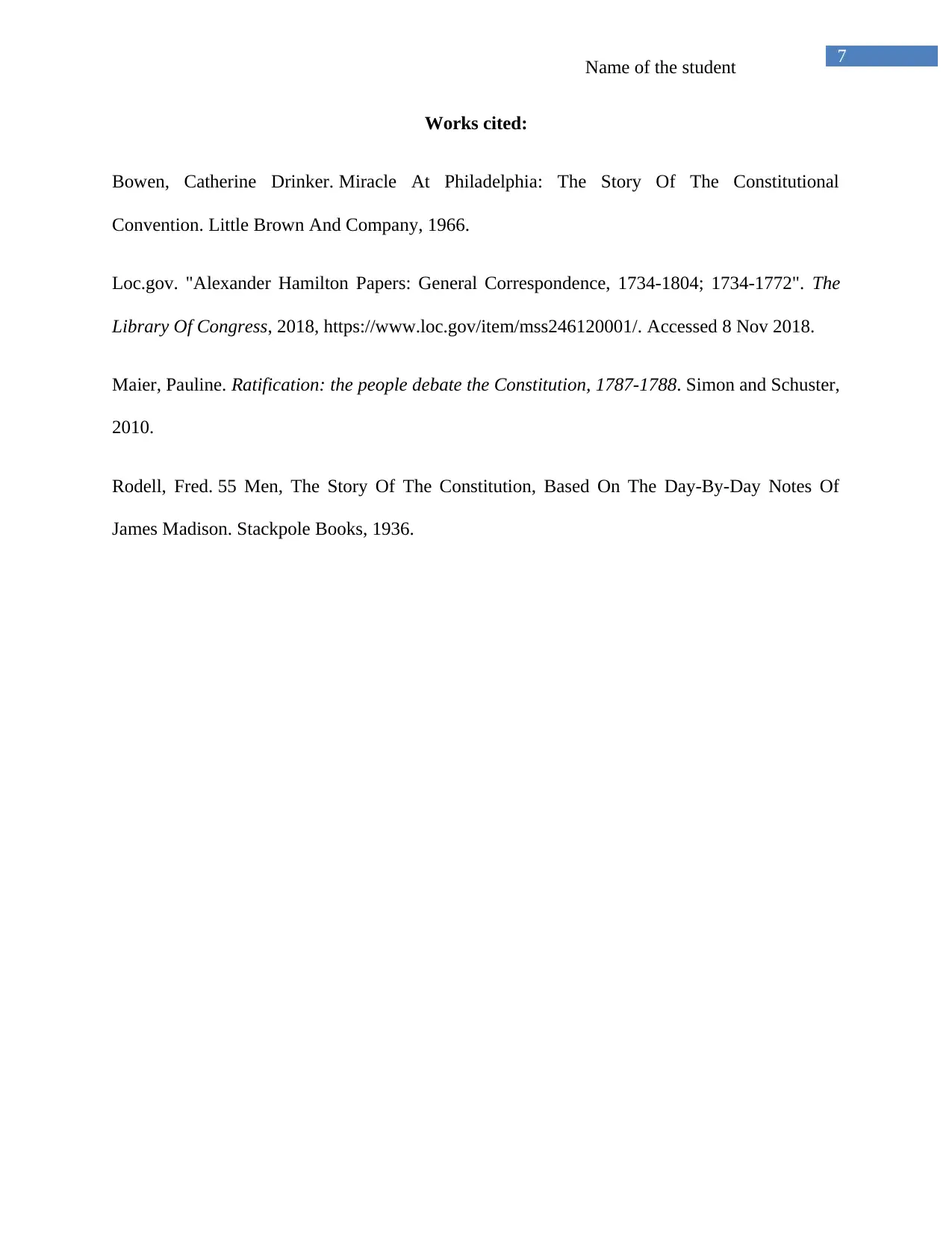
7
Name of the student
Works cited:
Bowen, Catherine Drinker. Miracle At Philadelphia: The Story Of The Constitutional
Convention. Little Brown And Company, 1966.
Loc.gov. "Alexander Hamilton Papers: General Correspondence, 1734-1804; 1734-1772". The
Library Of Congress, 2018, https://www.loc.gov/item/mss246120001/. Accessed 8 Nov 2018.
Maier, Pauline. Ratification: the people debate the Constitution, 1787-1788. Simon and Schuster,
2010.
Rodell, Fred. 55 Men, The Story Of The Constitution, Based On The Day-By-Day Notes Of
James Madison. Stackpole Books, 1936.
Name of the student
Works cited:
Bowen, Catherine Drinker. Miracle At Philadelphia: The Story Of The Constitutional
Convention. Little Brown And Company, 1966.
Loc.gov. "Alexander Hamilton Papers: General Correspondence, 1734-1804; 1734-1772". The
Library Of Congress, 2018, https://www.loc.gov/item/mss246120001/. Accessed 8 Nov 2018.
Maier, Pauline. Ratification: the people debate the Constitution, 1787-1788. Simon and Schuster,
2010.
Rodell, Fred. 55 Men, The Story Of The Constitution, Based On The Day-By-Day Notes Of
James Madison. Stackpole Books, 1936.
1 out of 7
Related Documents
Your All-in-One AI-Powered Toolkit for Academic Success.
+13062052269
info@desklib.com
Available 24*7 on WhatsApp / Email
![[object Object]](/_next/static/media/star-bottom.7253800d.svg)
Unlock your academic potential
Copyright © 2020–2025 A2Z Services. All Rights Reserved. Developed and managed by ZUCOL.



